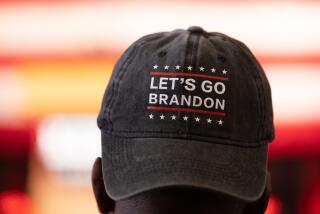Bernie Sanders never had this before: A campaign machine that’s crushing it

Reporting from Washington — The last time Californians voted in a presidential primary, Bernie Sanders’ campaign was so overextended and seat-of-the-pants that staff members nearly fumbled a solid-gold marketing opportunity.
Grass-roots “Bern, Baby, Bern” parties were raging in San Francisco — using a likeness of the Vermont senator superimposed on a “Saturday Night Fever” poster, a la John Travolta, to lure hundreds of fresh donors with the promise of disco dancing.
Organizers raised nearly $40,000 for the campaign, but were frustrated when they tried to transfer the Bernie-disco enthusiasm to the Bernie get-out-the-vote movement.
“We had to make and crank out our own campaign literature and figure out how to send canvassers out by ourselves,” said Ben Becker, 34, who organized the disco parties in the city’s Mission District with his wife, Claire Lau, 30.
“If and when the campaign staff did arrive, there were things they just did not get right,” said Lau, like failing to print campaign material in the native languages of key immigrant communities.
Now?
“It’s much different,” Becker said.
The Sanders campaign has evolved from an unruly movement four years ago into a highly disciplined, highly structured, proactive machine that is the envy of the Washington establishment. An operation spawned from antipathy toward corporate America now functions with the precision, focus and outsized bank account of, well, corporate America.
“They are much better able to harness all the organic energy this time,” said Ro Khanna, the Silicon Valley congressman who co-chairs the campaign. “There is an infrastructure that wasn’t there before. There are department heads watching every dollar, coordinating messaging, targeting effectively.”
It is an operation, he said, that functions very much like the one political strategist and former Uber executive David Plouffe set up when he managed Barack Obama’s 2008 campaign.
The February day Sanders launched his 2020 bid, the campaign was prepared when some 4,000 volunteers immediately emerged. Aides put them to work. They sent 1.3 million texts to other potential donors and volunteers. The campaign that limped into California the last time now may be better equipped there than anyone. There was no Iowa team in place at this point in the 2016 race; Sanders now has among the largest of all the Democratic presidential contenders.
Last time around, his campaign was so poorly managed that a frat-house culture of sexual harassment went unnoticed and uncorrected — only to burst into view as the senator prepared to launch his 2020 bid. The current challenge is not keeping track of an ever-growing army of grass-roots volunteers, but keeping them invested and feeling the movement is theirs as an apparatus of paid staffers nudges them to deploy in concert.
The scale and organization of what Sanders and his aides have built was on display over the weekend as the campaign mustered its resources to pull off a project none of its rivals would be able to match: Activists coming together at 4,700 house parties, with gatherings in every state and 30 countries.
House parties are standard campaign fare — but not 4,700 at once.
More than 800 took place in California alone, another signal that the democratic socialist is well positioned to compete not just in his proven battlegrounds of New Hampshire and Iowa, but also in the Golden State, where a big showing could put him on a path toward the nomination.
The star of the parties — other than Sanders himself — was a new mobile app called “Bern.” It’s intended to empower Sanders enthusiasts to find, catalog and mobilize every other potential supporter who drifts into their orbit, down to the guy at the bus stop who might compliment their “Bern, Baby, Bern” T-shirt. It goes well beyond engagement apps that previous campaigns have used.
“Our people power is a unique advantage,” said campaign manager Faiz Shakir. “We already have more than 1 million people involved. … This app gives them a way to input information so critical at the end of the day to how we build the concrete numbers in state after state.”
The technology, like so much else the campaign invests in now, is designed to overcome a hurdle it hit in the last race — when the campaign infrastructure couldn’t keep pace with voter enthusiasm, and eager volunteers were idled awaiting direction.
The 2016 operation “grew like a small online business that opened up one day, and all of a sudden orders started flooding in faster than we could supply them,” said Larry Cohen, a Sanders confidant and former head of the Communications Workers of America.
The new Bernie Inc. is like a relaunch after years spent in the lab, honing strategy, recalibrating and steadfastly developing a workforce. Through the affiliate organization Our Revolution, which Cohen chairs, activists nurtured the movement after 2016, fielding slates of candidates, seeding key Democratic Party committees with Sanders loyalists, and aggressively recruiting new activists.
Sanders helped keep supporters engaged in the political off-season through efforts like his homegrown “Bernie TV” operation, which attracted millions of viewers.
Many political pros expected Bernie 2.0 would go the same way as other lackluster campaign sequels: Rick Santorum, Mike Huckabee, Dennis Kucinich come to mind. That swiftly proved wrong. Instead, Sanders appears to have hardened the loyalty of his voters.
“Bernie Sanders invented the grass-roots campaign to scale,” said Matthew Donovan, a 32-year-old digital strategist for businesses who was among the dozen Sanders enthusiasts who showed up at a house party Saturday in L.A.’s Filipinotown. They huddled around the TV in a pink living room, consuming Rolling Rock beer and the motivational words of Sanders and Shakir, whose video messages beamed over the screen.
“Here is the bottom line: We need to put together the biggest grass-roots movement in the history of American politics,” Sanders said on the screen. “And we’re off to a good start.”
Sanders’ gravelly Brooklyn voice also crackled over house-party organizer Tony Rzeteljski’s cellphone, after he made an impromptu call to welcome his supporters. Rzeteljski remained in awe hours later.
“I need to get this embossed,” he said, staring at his phone.
Even as the operation now reflects a more traditional approach with a large staff of paid operatives and a headquarters in Washington, Sanders “is doing just enough, taking the actions that show he’s not going to be like the establishment Democrats with this campaign,” said Adriel Hampton, a political strategist in San Francisco who advises progressives.
Some Sanders loyalists felt dismayed, for example, when he called on surrogates to tone down their rhetoric and resist bullying and online harassment of opponents. That feeling dissipated when he threw them red meat with a recent attack on the Center for American Progress, a Washington-based think tank with close ties to the liberal Democratic establishment.
There were more cheers than hisses when Sanders recently hired as his chief of research a former high-level operative for Hillary Clinton, who had helped head efforts in the last campaign to dig up dirt on him. Sanders supporters saw the move as crafty and subversive, a page stolen from the playbook of the ruthless establishment.
“It was great that the campaign initially caught fire without being professionalized,” said Hampton. But it is even better that Sanders now has the resources and infrastructure to actually win, he said: “It is inspiring to see the kind of people they are hiring.”
Halper reported from Washington and Ormseth from Los Angeles.
More to Read
Get the L.A. Times Politics newsletter
Deeply reported insights into legislation, politics and policy from Sacramento, Washington and beyond. In your inbox three times per week.
You may occasionally receive promotional content from the Los Angeles Times.











